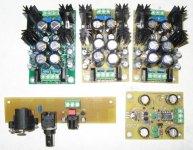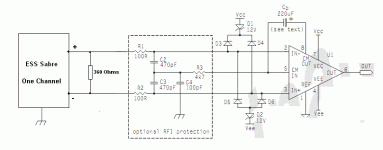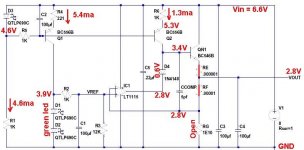Re: Buffalo - Level of Complexity
Hi Graham,
Many people with varying degrees of skill have completed finished DACs based on our modules.
Check out this thread for some more info:
http://www.diyaudio.com/forums/showthread.php?s=&threadid=128137&perpage=25&pagenumber=1
It is probably not the kit for an absolute beginner, but it is not very difficult either.
Cheers!
Russ
GrahamH said:I am just getting started into DIY audio and your DAC is just the component I would like to start with.
Hi Graham,
Many people with varying degrees of skill have completed finished DACs based on our modules.
Check out this thread for some more info:
http://www.diyaudio.com/forums/showthread.php?s=&threadid=128137&perpage=25&pagenumber=1
It is probably not the kit for an absolute beginner, but it is not very difficult either.
Cheers!
Russ
Re: Re: Buffalo - Level of Complexity
GrahamH said:Russ,
I am just getting started into DIY audio and your DAC is just the component I would like to start with. I have little skill in electronics assembly and even less understanding, but want to start somewhere fun and interesting. Do you feel your Buffalo kit would be jumping into the deep end or could I reasonably start there?
Cheers,
Graham
[i
Twisted Pear kits are absolutely right for new comers; they are simple to assemble and connect. This assumes that you can solder properly.
Because Russ is prepared to asnwer questions clearly, this makes it easier to commission as well.
Re: Re: Re: Re: Es9018
I have heard rumours that the new chip is supposedly easier to use in hardware mode (i.e. standalone, or without a microprocessor). Is this true, and if so, exactly how is it easier to use? This question has been itching my mind for a while.
dusfor99 said:Hi Cauhtemoc,
I can answer "some" questions with no problems, but there are some areas I am not allowed to go into. It never hurts to ask. So what are you curious about? 🙂
Dustin
I have heard rumours that the new chip is supposedly easier to use in hardware mode (i.e. standalone, or without a microprocessor). Is this true, and if so, exactly how is it easier to use? This question has been itching my mind for a while.
THD performance
Hello dusfor99
With ES9018 what is the THD at 10kHz is it -120dB like at 1KHz.
What is the PSRR of the the 3.3V analog supply with respect to the current ouput configuration.
Reagards.
Arthur
Hello dusfor99
With ES9018 what is the THD at 10kHz is it -120dB like at 1KHz.
What is the PSRR of the the 3.3V analog supply with respect to the current ouput configuration.
Reagards.
Arthur
Re: Re: Re: Re: Es9018
I'd like to understand better the capabilities which are exposed by letting users set the filter characteristics. For example, is there enough flexibility to do a design which has a stereo signal coming in and splitting it for each channel into three (six outputs total) to drive active 3-way speakers? For a given channel how much flexibility is there in the filter. For example, how many taps does it have? What bit length the coefficients and what bit length for the internal arithmetic?
Peter
Dear Dustin,dusfor99 said:I can answer "some" questions with no problems
I'd like to understand better the capabilities which are exposed by letting users set the filter characteristics. For example, is there enough flexibility to do a design which has a stereo signal coming in and splitting it for each channel into three (six outputs total) to drive active 3-way speakers? For a given channel how much flexibility is there in the filter. For example, how many taps does it have? What bit length the coefficients and what bit length for the internal arithmetic?
Peter
Re: Buffalo - Level of Complexity
fmak and Russ,
Thanks for the advice. I have been practicing my soldering and with the great support in this forum feel comfortable going for it. Since it seems that the revised Buffalo might still be a few days/weeks away, I am going to start with the IVY + LCBPS kits. Practice there and then move on to the Buffalo when it is ready.
Thanks again.
Graham
fmak and Russ,
Thanks for the advice. I have been practicing my soldering and with the great support in this forum feel comfortable going for it. Since it seems that the revised Buffalo might still be a few days/weeks away, I am going to start with the IVY + LCBPS kits. Practice there and then move on to the Buffalo when it is ready.
Thanks again.
Graham
Re: Re: Re: Re: Re: Es9018
Hi Cauhtemoc
THe chip will now autodetect if the input stream on data1 is SPDIF or not. If its not, it will try to see if its I2S or DSD. SO there is not need for a MCU to program it to get it into SPDIF mode.
Dustin
Cauhtemoc said:
I have heard rumours that the new chip is supposedly easier to use in hardware mode (i.e. standalone, or without a microprocessor). Is this true, and if so, exactly how is it easier to use? This question has been itching my mind for a while.
Hi Cauhtemoc
THe chip will now autodetect if the input stream on data1 is SPDIF or not. If its not, it will try to see if its I2S or DSD. SO there is not need for a MCU to program it to get it into SPDIF mode.
Dustin
Re: THD performance
THD+N unweighted is 120 db from 20 to 20k
Dustin
PHEONIX said:Hello dusfor99
With ES9018 what is the THD at 10kHz is it -120dB like at 1KHz.
What is the PSRR of the the 3.3V analog supply with respect to the current ouput configuration.
Reagards.
Arthur
THD+N unweighted is 120 db from 20 to 20k
Dustin
Re: Re: Re: Re: Re: Es9018
Hi Peter,
The bit lenght for the coefficients is 32, the inter MAC unit is 64 bits. Each of the 8 channels can have its own unique coefficients. ThIs is ideal for making an active Xover that will not have an phase problems. (well other than the speakers phase responce itself). We are almost done with a new GUI that can be used if you have a demo board that actaully has a graphical filter builder built into it. Soon..
Dustin
schro20 said:
Dear Dustin,
I'd like to understand better the capabilities which are exposed by letting users set the filter characteristics. For example, is there enough flexibility to do a design which has a stereo signal coming in and splitting it for each channel into three (six outputs total) to drive active 3-way speakers? For a given channel how much flexibility is there in the filter. For example, how many taps does it have? What bit length the coefficients and what bit length for the internal arithmetic?
Peter
Hi Peter,
The bit lenght for the coefficients is 32, the inter MAC unit is 64 bits. Each of the 8 channels can have its own unique coefficients. ThIs is ideal for making an active Xover that will not have an phase problems. (well other than the speakers phase responce itself). We are almost done with a new GUI that can be used if you have a demo board that actaully has a graphical filter builder built into it. Soon..
Dustin
Re: Re: Re: Re: Re: Re: Es9018
Thanks. This is exactly what I had hoped for, and it's a feature that should clearly have been in the old DAC.
What can you tell us about the new ADC? Could you tell us the DNR for example, as this is something that appears to be missing from the product brief on your website. It also appears that the ADC does not require a microcontroller, and all configuration is done via pin-strapping, is this correct?
dusfor99 said:Hi Cauhtemoc
THe chip will now autodetect if the input stream on data1 is SPDIF or not. If its not, it will try to see if its I2S or DSD. SO there is not need for a MCU to program it to get it into SPDIF mode.
Dustin
Thanks. This is exactly what I had hoped for, and it's a feature that should clearly have been in the old DAC.
What can you tell us about the new ADC? Could you tell us the DNR for example, as this is something that appears to be missing from the product brief on your website. It also appears that the ADC does not require a microcontroller, and all configuration is done via pin-strapping, is this correct?
Re: Placid
Placid is undergoing redesign to make it more user friendly. 🙂
Until then, LCBPS is actually a great choice for counterpoint (assuming I can get past this turn off issue).
Cheers!
Russ
Studley said:Guys
you have mentioned the Counterpoint is getting near. Any news on the Placid?
Ian
Placid is undergoing redesign to make it more user friendly. 🙂
Until then, LCBPS is actually a great choice for counterpoint (assuming I can get past this turn off issue).
Cheers!
Russ
Re: Re: Re: Re: Re: Re: Es9018
Hi Dustin,
How long is the FIR filter (or is it IIR filter?)
Where can I download a product datasheet of this new chip with all the details for design. Or how can I get it or sign to get it.
Is also data of the new ad converter available?
Some time ago I did sent an email to the dutch/belgium representative but did not get an answer yet. Someone told me they are not very active. I do not know if this is true, but anyhow I did not get an answer.
Ronald
dusfor99 said:
Hi Peter,
The bit lenght for the coefficients is 32, the inter MAC unit is 64 bits. Each of the 8 channels can have its own unique coefficients. ThIs is ideal for making an active Xover that will not have an phase problems. (well other than the speakers phase responce itself). We are almost done with a new GUI that can be used if you have a demo board that actaully has a graphical filter builder built into it. Soon..
Dustin
Hi Dustin,
How long is the FIR filter (or is it IIR filter?)
Where can I download a product datasheet of this new chip with all the details for design. Or how can I get it or sign to get it.
Is also data of the new ad converter available?
Some time ago I did sent an email to the dutch/belgium representative but did not get an answer yet. Someone told me they are not very active. I do not know if this is true, but anyhow I did not get an answer.
Ronald
Just completed most of the support PCB for my Buffalo. One LCDPS for the digital supplies, two LCBPS (my own PCB and parts choice) for the upcoming CounterPoint ver2, the digital input PCB with AES/EBU, True 75 ohms BNC and optical SPDIF using the TORX142L (192Khz speed support). The RCA is not mounted because I'll use the USB input card for the forth input into the CS8416 MUX.
There is also the small Simple Reg PCB for the Buffalo analog reference modification. The MUX is all assembled as well as the Buffalo. I just need to complete the USB card and wait for the Counterpoints.
There is also the small Simple Reg PCB for the Buffalo analog reference modification. The MUX is all assembled as well as the Buffalo. I just need to complete the USB card and wait for the Counterpoints.
Attachments
In fast roll-off mode: The filter is a two stage FIR. The first stage is 512 taps (cosine symmetry). The second stage can be up to 28 taps (either sine or cosine symmetry).How long is the FIR filter (or is it IIR filter?)
In slow roll-off mode: The filter is now a single stage FIR with 64 taps (no symmetry required).
You'll have to get in touch with marketing at ESS for a full data sheet. Alternatively, the new Sabre32 GUI help files contain all of the register definitions (if that's what you're looking for). An alpha version is available on the website. http://esstech.com/index.php?p=support_downloadsWhere can I download a product datasheet of this new chip with all the details for design. Or how can I get it or sign to get it.
GUI
Hi Giawa. I notice that you are from Kelowna.
Does that mean that we now have another source of insider information?
😀
I downloaded the new GUI, but it looks like I can't play with the filter designer unless I have a new demo board attached.
Hi Giawa. I notice that you are from Kelowna.
Does that mean that we now have another source of insider information?
😀
I downloaded the new GUI, but it looks like I can't play with the filter designer unless I have a new demo board attached.
Hi rossl, there's a new version posted that has the filter designer as a stand-alone application. You should now be able to use it without a demo board attached.I downloaded the new GUI, but it looks like I can't play with the filter designer unless I have a new demo board attached.
http://esstech.com/index.php?p=support_downloads
I don't know if 'insider information' is the right phrase 😉Does that mean that we now have another source of insider information?
512 taps that isn't a huge amount of filtering potential. I wonder if there is even
any significant signal delay capability?
any significant signal delay capability?
Hi Russ. I assembled the Simple Reg modification PCB for the Buffalo and I'm testing it right now. In your latest schematic with notes, you mentioned that the Vref can be changed by changing the R3 value.
Reference to the enclosed schematic with my measurements results.
I can only get 2.8V at Vout, changing R3 cause small variation from 2.75 to 2.85, but that about it. All the other currents you recommended (R4 > 4ma, R6 > 1ma, R1 >4ma) are meet. The two leds reference source D1-D2 (green leds) is 3.9V. The way I see it, R2,R3 form a simple voltage divider, not loaded by the high input impedance of IC1, so the ratio of Vled X (R3/R2+R3) should fix the Vref value. I should be able to adjust R3 to get Vref 3.3V but I cannot. By the way I'm using the circuit with jumper (short) used for Re and Rf.
Any suggestions?
Is the value of 2.8V enough for the Vref value on the Buffalo PCB, or is it too low?
Thanks for any help you can provide.
Reference to the enclosed schematic with my measurements results.
I can only get 2.8V at Vout, changing R3 cause small variation from 2.75 to 2.85, but that about it. All the other currents you recommended (R4 > 4ma, R6 > 1ma, R1 >4ma) are meet. The two leds reference source D1-D2 (green leds) is 3.9V. The way I see it, R2,R3 form a simple voltage divider, not loaded by the high input impedance of IC1, so the ratio of Vled X (R3/R2+R3) should fix the Vref value. I should be able to adjust R3 to get Vref 3.3V but I cannot. By the way I'm using the circuit with jumper (short) used for Re and Rf.
Any suggestions?
Is the value of 2.8V enough for the Vref value on the Buffalo PCB, or is it too low?
Thanks for any help you can provide.
Attachments
- Home
- Source & Line
- Digital Line Level
- ESS Sabre Reference DAC (8-channel)


